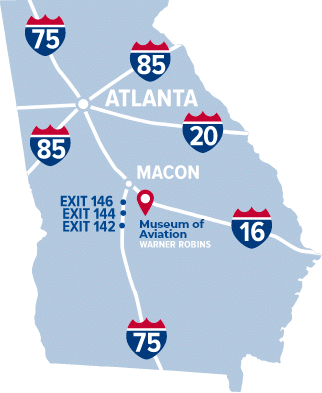Last week we looked at some flags from the observation gallery on the third floor of the Eagle Building here at the Museum of Aviation. In part II of that post we will look at three flags from the Confederate States of America as well as several variants of the “Don’t Tread on Me” motto as used on flags. Some of these flags are still in use today.
The Green Mountain Boys Flag was used by the likewise named militia force commanded by Ethan Allen. The militia was formed to defend the property of people in what is today the state of Vermont and went on to serve in the Revolutionary War, War of 1812 and the Spanish-American War. Both the flag and the name Green Mountain Boys are still in use today by the Vermont National Guard.
Tradition states that the “Don’t Tread on Me” design was first used by the Continental Navy in 1775. This jack (a type of naval flag flown at the head of a ship) has become a powerful American symbol and is still currently in use with the U.S. Navy. The rattlesnake was first used as symbol of the Colonies by Benjamin Franklin in his “Join or Die” political cartoon around 1754. The rattlesnake was used, among other reasons, because it gives a warning and doesn’t strike until provoked.
A snake as a symbol of the Colonies is most often attributed to Benjamin Franklin and his famous editorial cartoon. This version of the “Don’t Tread on Me” flag was designed by Colonel Christopher Gadsden. The flag first flew in combat with the Navy in February of 1776 and is one of most recognized versions of the type.
Minutemen of Colonel Patrick Henry’s First Virginia Regiment from Culpeper, Virginia, used this flag during the Revolutionary War. The flag differs from other “Don’t Tread on Me” designs by adding a section of Patrick Henry’s “Liberty or Death” quote.
State Flag of California – A group of settlers in California declared independence from Mexico in 1846 under the original variant of this flag. The California Republic was never officially recognized and lasted a total of 26 days until the United States claimed the area. The original flag was lost in the fires that followed the Great 1906 San Francisco earthquake.
Commonly called the “Stars and Bars,” the Confederate First National Flag is not the flag that most think of when the Civil War is mentioned. It was adopted with seven white stars in March 1861 with stars added as new states joined the Confederacy. The final version in November of 1861 had 13 stars.
Confederate leadership felt that the “Stars and Bars” was too close in appearance to the United States Flag and therefore adopted the Confederate Second National Flag in May of 1863. A red stripe was added to this version in March of 1865 to avoid the confusion of looking like a surrender flag. This final version was known as the Confederate Third National Flag.




















